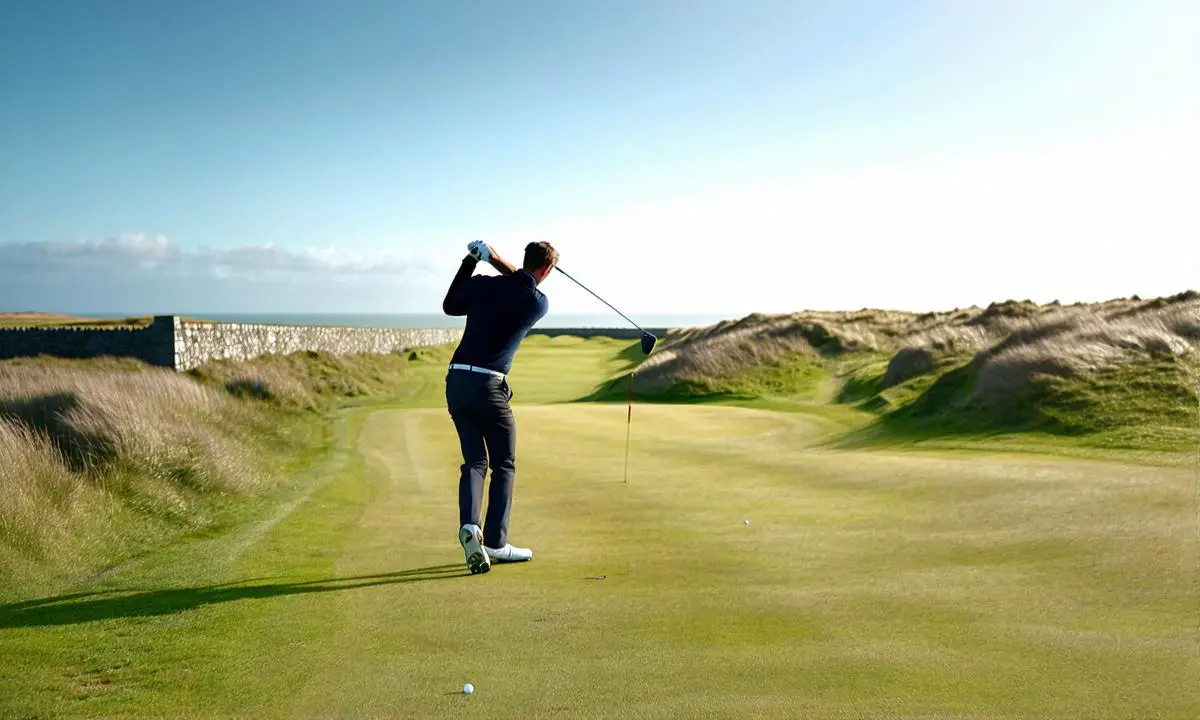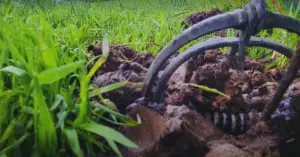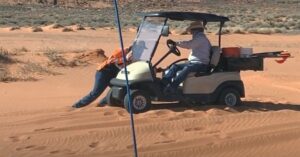What Is A Links Course In Golf: 7 Key Features Explained
Golf’s allure often lies in its variety, and links courses stand out for their unique charm. These coastal gems offer players a distinct experience shaped by natural terrain and ever-changing weather conditions.
A links course in golf features rolling hills, sandy soil, and grassland close to the coast. Unlike parkland courses with abundant trees and water hazards, links courses emphasize the elements of wind and firm fairways.
The creation of these courses comes from centuries-old traditions that provide modern golfers with both challenge and beauty. Stay tuned as we dive deeper into what makes links courses special and how they differ from other types of golf layouts.
What Are the Key Features of a Links Course in Golf?

The charm of a links course comes from its distinctive features, which set it apart from other golf layouts. Players encounter various elements that create both beauty and challenge on these courses.
1. Coastal Location: Most links courses sit right by the coast, often overlooking the ocean. This setting contributes to beautiful scenery but also brings strong winds that test golfers’ skills.
2. Natural Terrain: The undulating landscape is shaped by nature rather than design. Rolling hills and dips create unpredictable lies, making club selection crucial.
3. Firm Fairways and Greens: With sandy soil as a foundation, fairways tend to be firm and fast. This characteristic requires players to adjust their approach shots for accuracy and distance control.
4. Minimal Tree Cover: Unlike parkland courses lined with trees, links courses have very few obstacles above ground level. This feature allows wind to play a larger role in gameplay while presenting open views across the course.
“The wind is one of the biggest challenges on a links course.” — Paul McGinley, Professional Golfer
5. Pot Bunkers: These iconic sand traps are often deep and strategically placed throughout the layout. They require careful navigation since getting out can prove difficult if you’re not prepared!
6. Grass Types: Links courses primarily utilize fescue grasses for their roughs and greens due to their resilience against changing weather patterns—particularly salt spray from coastal conditions.
7. Unique Challenges Year-Round: Weather changes dramatically on links courses based on season or time of day; this variability makes every round unique! Rainy days may lead to soggy conditions while bright sunny afternoons can see fierce gusts transforming how you play each hole.
Essential Strategies for Playing on Links Courses Effectively
Playing on a links course can be both rewarding and challenging. Understanding the unique characteristics of these courses allows golfers to adapt their strategies accordingly.
1. Embrace Wind Conditions: The wind plays a pivotal role in links golf. Learning to read the wind direction helps you choose the right club and shot shape. For example, when facing strong winds, consider using lower lofted clubs to keep your ball flight down.
2. Master Your Short Game: Since links courses often have firm greens, honing your chipping and putting skills is essential. Use different kinds of chips from various lies, experimenting with bounce and roll techniques until you find what works best for you.
“Great golf swings are important but great short games get it done.” — Mark O’Meara, Professional Golfer
3. Play Strategically Around Bunkers: Pot bunkers are common hazards that can catch even experienced players off guard. Plan your shots carefully to avoid these traps; sometimes it’s better to play safe rather than attack pins guarded by sand.
4. Adjust Your Approach Shots: Using more club than usual can help counteract unpredictable terrain changes and firm fairways found on links courses. For instance, if you’re typically comfortable hitting an 8-iron from 150 yards out, consider opting for a 7-iron instead when conditions are dry.
Selecting the Right Equipment
Your choice of equipment influences how effectively you navigate a links course’s challenges.
If possible, use low-compression balls that perform well in windy settings and provide extra distance on firmer ground.
| Condition | Recommended Club Type |
|---|---|
| Calm Winds | Standard Irons/Woods |
| Strong Winds | Low Lofted Woods/Fewer Clubs |
5. Track Your Ball Flight: On a links course where height often leads to havoc due to wind effects—monitor how high or low each shot goes gives valuable insights into adjustments needed for subsequent attempts.
The Importance of Patience: Lastly, accepting that not every hole will play according to strategy is vital.
A skilled golfer knows adaptation comes hand-in-hand with patience during sudden weather shifts or unexpected results!
How Do Weather and Terrain Impact Your Links Golf Game?
The weather and terrain on links courses present a unique challenge for golfers. Understanding these elements can significantly improve your performance on the course. Let’s break down how they influence gameplay.
Weather Conditions: Embrace the Elements
Links courses are known for their coastal settings, often exposing players to unpredictable weather patterns. For instance, wind speeds can vary dramatically throughout the day.
A study from the Royal Meteorological Society highlights that average winds near coastlines can reach 15-20 mph regularly. This means you’ll need to adjust your shot selection based on current weather conditions.
- Rain: Light rain might soften greens, affecting ball speed. However, heavy rain can create puddles in low-lying areas of fairways.
- Sunshine: While sunny days offer excellent visibility, they may also lead to quick-drying greens and faster play.
- Cumulus Clouds: Cloud cover can temporarily shield you from strong winds but also change temperatures rapidly during play.
“Adapting to changing weather is as vital as mastering your swing.” — Lee Trevino
The Role of Terrain in Gameplay
The distinctive terrain of links courses adds another layer of complexity. Rolling hills and natural undulations affect ball lies significantly, demanding thoughtful strategies for navigating each hole.
| Terrain Feature | Impact on Play |
|---|---|
| Hollows/Dips | Can cause uneven lies; approach shots require extra caution. |
| Elevated Greens | Add difficulty by making distance judgment critical when putting or chipping. |
| Firm Fairways | Allow for longer rolls but necessitate precision with iron shots due to bounce unpredictability. |
Your choice of clubs should reflect these variables—using more lofted clubs in hilly areas or adjusting angles based on tight lies is essential for successful shots on diverse terrains.
Pay attention to how both weather shifts and terrain variations change throughout your round—this knowledge will allow you to make informed decisions that enhance your chances at successfully scoring lower!
FAQs
What makes links courses different from parkland courses?
Links courses focus on natural terrain and minimal trees, while parkland courses often feature lush landscapes with more obstacles. This difference affects strategy and shot selection for golfers navigating each type of course.
How does wind affect play on links golf courses?
The strong coastal winds present unique challenges on links courses. Golfers must learn to read the wind direction to adjust their shots, affecting both club choice and overall ball trajectory during play.
What types of grass are common on links golf courses?
Links courses primarily use fescue grasses because they can withstand harsh coastal weather conditions. The resilient nature of these grasses helps maintain fairways and greens throughout varying seasonal climates.



![How To Play Sand Hills Golf Club? [A Golfer's Guide] how-to-play-sand-hills-golf-club](https://giftedgolfers.com/wp-content/uploads/2023/05/how-to-play-sand-hills-golf-club-300x157.jpg)


